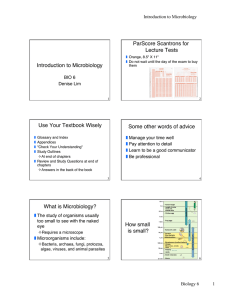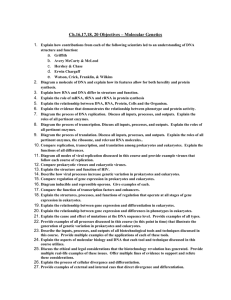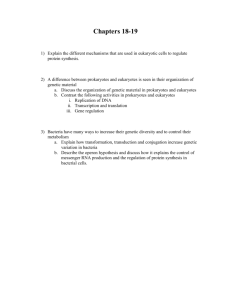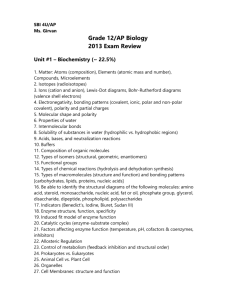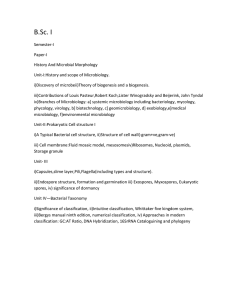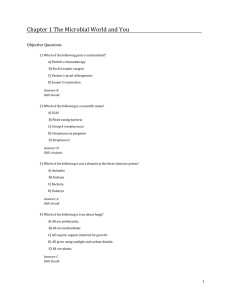notes - Belle Vernon Area School District
advertisement
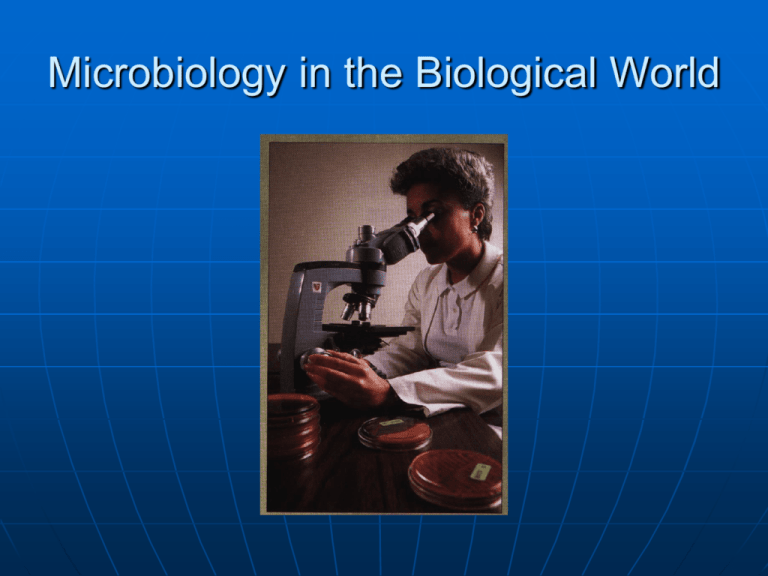
Microbiology in the Biological World Why study Microbiology? 1. Helps us to understand life forms by understanding ones. 2. of infectious diseases (Small pox, Typhoid fever, Cholera). 3. Various . Evolution of Microbiology 1. was the first to observe the microscopic world with a 3X microscope (1632-1723). 2. Observed cork & termed the word “ ”. - 2. Theory of Spontaneous Generation (SG). Organisms appeared out of no where. Ex. If meat was left out flies appeared. A. - disproved (SG) in higher organisms but not in microorganisms. B. - supported (SG) in microorganisms. • After sterilization (Boiling) microorganisms still arouse. C. - disproved (SG) by conducting an experiment using bottle swan neck flask. Proved that dust must carry microorganisms. D. heating - - dust carries bacteria that can grow after - heat stable form of bacteria. 3. Fermentation - First problem as a microbiologist was to discover why the production of alcohol from sugar beets would occasionally produce lactic acid. 1. 2. DISCOVERED two types of bacteria - required - does for survival require oxygen 4. Germ Theory 1834 - first time disease was linked to an microorganism. A. - disease in silk worm was a result in a fungus infection. B. C. - credited with the first attempt to prevent post surgical infection by using diluted phenol. D. - developed rules to establish a cause & effect relationship between an microorganism & a disease. - 1865 - similar work. • Koch’s Postulates 1. 2. 3. 4. Microbiology Stepping Stones Divisions of Microbiology 1. - study of microorganisms that cause disease in humans & animals. 2. - reaction of a host to the infection. 3. -alcohol beverages, antibodies. 4. - harmful or beneficial to the production of agricultural products. 5. Synthesis of vaccine. - recombinant DNA. Human insulin. Medical Microbiology Past Triumphs 1. Small Pox Viral disease - 10 million peopled died No cases reported since 1977 2. Bubonic Plague Bacterial Disease - 25 million people died 100 people die/year from it Future Challenges Not all diseases are under control. 1. million cases of infections /year in US (22,000 deaths) 2. Lyme disease, 3. New diseases may emerge ( 4. Old diseases are on the increase in US ’, AIDS, Hantavirus. ). A. Travelers from foreign countries - 1 in 5 vistor’s come from a country with Malaria, Yellow fever, & Cholera. B. Resistant microbes. C. Medicines are increasing the life span, therefore immune system weakens in elderly people. D. Children in developing countries were under controlled (mumps, whooping cough, measles). Parents lax about vaccinating children. Cell Theory 1. Cell is the fundamental unit of life & cells come from pre-existing cells (1839 - Schleiden & Schwann). Similarity in Function & Composition of Cells All cells have the same problems: 1. Reproduce copies of itself. 2. Obtain & use for reproduction. Solutions 1. reactions. 2. 3. 4. 5. 6. - protein molecules to speed up chemical - genetic information. protein synthesis. energy. help enzymes. building blocks of proteins. Origin of Life First form of life appeared about Earth’s environment High temperature, , catalyzed to formed amino acids (AA). . & lighting Proven by Conducted experiments where he replicated early Earth’s environment & by inducing a spark ’s were formed. Eventually over time • => => => Other organic compounds were mixed in until a being developed capable of directing synthesis of simple organic molecules. In time self replication - . Prokaryotic First cells were Prokaryotes, then over time developed into Eukaryotes. Prokaryotes 1. No intracellular 2. . present with . 3. • . DNA not separated from the rest of the cell Eukaryotes 1. Intracellular membranes present (organelles). 2. Cell membrane present with cell always . 3. . DNA was separated from the rest of the cell. 4. DNA - 4. DNA -proteins – 5. DNA continuous thread. chromosomes. 5. DNA separated into of chromosomes dependent on the species. 6. Reproduce Binary fission. 6. Reproduction . & Prokaryotic vs Eukaryotic Prokaryotes Eukaryotes Prokaryotes can be divided into two major groups. 1. (true bacteria) 2. - grow in hostile environments, but little micorbiolgical importance. Microbial world study of all prokaryotes & unicellular eukaryotes. Kingdom Monerans and Archaebacteria - Algae & Protozoans • Reproduction sexual & asexual - smaller than protozoans & are the major cause of diseases. • Cyanobacteria - photosynthesis - large multicellular eukaryote worms (flat & round). Domains - filamentous & unicellular eukaryotic cells. Some cause diseases. - 1 cell fungus, budding spores, breads & alcoholic beverages, few produce human diseases. - Multicellular, asexual & sexual spores, flavor fine cheeses, few produce human diseases. Infectious Agents - Smallest known disease agent. • DNA or RNA surrounded by a protein coat. Bacteriophages - infect bacteria. coat. - small piece of RNA that does not have a protein - Proteins without DNA or RNA. Microbial world Microbial world Microbial world Cell Size
